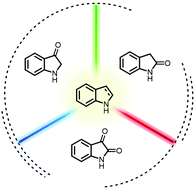Visible light-mediated chemistry of indoles and related heterocycles
Abstract
The use of visible light and photoredox catalysis emerged as a powerful and sustainable tool for organic synthesis, showing the high value of distinctly different ways of bond creation. Indoles and related heterocycles are widely-present in natural products, biologically active compounds, drugs, and agrochemicals. This review summarises the impact of visible light-promoted chemistry on the functionalization of indoles and on the synthesis and modification of indolines, indolin-2-ones, indolin-3-ones, and isatins. Almost 100 references starting from 2012 are cited.



 Please wait while we load your content...
Please wait while we load your content...